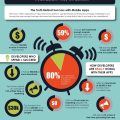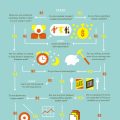What is cloud computing? Definition, Trends, and Predictions About “The Cloud”
“The Cloud“, “in the cloud” has become very popular words recently and this is not accidental. Have you ever wondered what “moving to the cloud” means … going to paradise, maybe? Yes, probably, but as far as this site stays business oriented, we won’t consider it in this aspect :). OK, let’s move to the matter… cloud computing has nothing to do with angels and paradise, except that, they will probably use it soon, too. Yes, this appears to be the next hot sector of the IT industry in the world. Everything has been moving to the ‘cloud’ for the last several years and this is why extremely important for everyone to know its basics.
Cloud Computing Definition
Cloud computing is a form of on–demand computing where computing services, such as computing power and storage, are provided over the internet on a pay–as–you–go basis. It is a way of accessing data and applications over the internet, without needing to be installed or maintained on a physical device. It eliminates the need for servers and other hardware, allowing businesses to save money and time.
In cloud computing, businesses can access a set of services and applications hosted on a cloud platform. Services such as software and storage are delivered over the internet, enabling businesses to access these services from anywhere. The cloud can also be used to store and manage large amounts of data and applications and can provide businesses with the ability to quickly scale to meet business demands.
With cloud computing, businesses no longer need to invest in expensive hardware and maintain the needed IT infrastructure. Instead, businesses can pay for access to the needed services and applications on an as–needed basis. This allows businesses to save time and money, as they don’t need to invest in hardware and IT teams to maintain the system.
Cloud computing also allows businesses to improve collaboration, data security, scalability, and business agility. With cloud computing, data and applications can be accessed securely and quickly, no matter where they are located. This allows businesses to share data and collaborate easily across different locations. It also provides businesses with the ability to quickly scale services and applications to meet business demands.
Overall, cloud computing is an efficient, cost–effective way of accessing computing services, data, and applications over the internet. It eliminates the need for businesses to invest in expensive hardware and infrastructure and provides businesses with the ability to quickly scale to meet business demands. It is an ideal solution for businesses looking to reduce costs and increase agility.
Why should one use remote software and hardware instead of installing everything on her computer?
This is probably the following question after reading all of the above. Well, the answer is simple. You should use the cloud because it has so many advantages.
Pros and Cons of Cloud computing (Advantages and Disadvantages)
Pros
1. It’s cheap – a license for software may cost really a lot, and it may be really expensive for someone to buy it. If you use it in the cloud, you actually pay a monthly rent for it which is a substantially cheaper option in the short run. Also, you don’t need to pay for people to administer your server or maintain your software. it’s all included in the rent and you get highly skilled professionals doing that. You don’t buy hardware, too. Cloud computing lets you start using cutting-edge software and hardware with an extremely low starting budget, but in some cases, it may be the more expensive option (see the cons).
2. You pay for what you use – cloud services can easily be expanded or collapsed. If you need another license of software, you can just pay the additional rent for it. You don’t have to buy it and pay its full price. If you need to reduce your licenses, you just stop renting them and pay for just what you use.
3. It’s accessible – you can use your ‘cloud’ from everywhere with an available Internet connection. You can use it usually from any device and operating system.
4. It’s secure – the administrator of the cloud services are highly skilled and professionally focused guys and gals. If you want to achieve such security for your in-home/in-office server, you need to pay big time for good employees and other devices such as UPSes to achieve it. all of this is included in the rent of a cloud service and it’s much more affordable.
5. You are always up to date – cloud services usually use the latest version of software and hardware components to stay competitive. If you have to do this in your office, it will be much more expensive.
Cons
1. You don’t have full control over your server and software – you may want to use an old version of the software, but your cloud vendor will upgrade it without asking you. They will do this for good, but not every time their good is your good. You always have to conform and adapt to some things
2. It’s more expensive in the long run – in the long run, cloud computing can be more costly than buying and maintaining everything yourself, but this is just in some cases.
3. Risk of unauthorized access – as all your files and data are in the cloud and managed by other people, there is always a risk of someone having unauthorized access to them. It’s small, but it’s there.
4. You need the Internet – if you don’t have an Internet connection, you will not be able to use your Saas/cloud service.
So, these from above are some of the main advantages and disadvantages of cloud computing and Saas. You can browse the internet to find some more if you need to.
If you are having a server with your software in the office, you also have to pay for a whole team of IT specialists to configure, maintain, repair, and update the software. Also, the software itself could be really expensive, especially if we are talking about an ERP system for instance. And if all of this stuff is not organized well, this could turn into a nightmare for the company…
Here comes “the cloud” as a solution to all of these problems! You will never need to take up any more of your time with hardware and software! You will just use them as intended! Also, applications based in the cloud can be up and running for months and even years, they will always be updated on time and secured properly.
Some Forecasts
As you see there are many benefits of cloud computing services. They are most commonly used with ERP and CRM apps, and other specialized programs, which are relatively expensive, but soon even notepad will be used in the cloud. This is really important for smaller companies, which can not afford ERP software. According to some forecasts, during the next five years, there will be a boom in cloud services around the world. The “cloud market” is expected to increase 5 times in some countries!
Cloud computing has been revolutionizing the technology industry for over a decade now and its growth shows no signs of stopping any time soon. By 2021, the global cloud computing market is expected to reach $721.3 billion, up from $272 billion in 2019.
It is expected that cloud computing will continue to become an increasingly important part of businesses and organizations in many different industries. For example, healthcare organizations are beginning to rely heavily on cloud computing systems, as they are able to provide the reliable, secure infrastructure needed to store and analyze large datasets. Similarly, many educational institutions are turning to cloud computing to facilitate remote learning and collaboration.
In the coming years, cloud computing will also become more and more integrated with the Internet of things (IoT). This will enable companies to better access and collect data from a variety of connected devices. Additionally, the edge computing market, which is closely related to cloud computing, is projected to grow from $2.5 billion in 2018 to $6.72 billion by 2024.
Finally, companies are becoming increasingly aware of the need for data security, which is another area where the cloud will experience accelerated growth. As organizations turn to cloud computing for core processes, they will need to ensure that their data is secure, both in terms of storage and protection. This will drive investments in cloud security solutions, such as identity and access management solutions, data encryption, and data loss prevention systems.
Also just have a look at the increase in the number of searches for “cloud computing” with Google!
It is going to be a hot business idea for the next several years. If you haven’t thought about such a business, I think you should! This market has already started to grow rapidly and is expected to do so for at least five years.
Are you still wondering how to start? Why don’t you check this out: start a cloud business
I hope you find all least plenty of companies, that can offer you business in this field.
The Biggest Trends in Cloud Computing Today
Cloud computing has become one of the most important technological advances in the last decade, driving innovation across industries. As it continues to grow, its capabilities become more complex, allowing businesses to gain a competitive edge over their peers. This article will offer an overview of the biggest trends in cloud computing today.
The biggest trend in cloud computing is the “as a Service” model, commonly referred to as Software–as–a–Service (SaaS). This has become the go–to option for many businesses, allowing them to access the latest software applications and services without having to pay upfront costs. With SaaS, businesses can quickly scale up or down as needed, saving them time and money while ensuring they are up–to–date with the latest applications.
Another trend in cloud computing is the use of containers. Containers are isolated environments that enable different software applications to run in isolation on the same server. This simplifies things for both developers and IT operations, making it easier to develop and deploy applications quickly. Containers are becoming increasingly popular due to their ability to offer faster and more efficient ways of working than traditional virtual machines.
The cloud is also being used to enable the Internet of Things (IoT). IoT is a network of connected devices that work together to provide data and other services. This is increasingly being used in industries such as healthcare, where devices and sensors can be used to monitor the health of patients and send warning notifications in the event of a medical emergency. IoT devices also have the potential to transform the retail industry, allowing for real–time data to be collected and analyzed.
The last trend in cloud computing is Artificial Intelligence (AI). AI is becoming increasingly important as companies look for ways to automate processes and improve customer service. AI can be used to automate mundane tasks such as data entry and customer service, as well as more complex tasks such as predicting customer behavior and making recommendations. This technology is set to revolutionize the way businesses operate, allowing them to become more efficient and effective.
These are just a few of the biggest trends in cloud computing today. As technology continues to evolve, it is likely that new and exciting advancements will be made. Businesses that embrace the cloud and adopt these new technologies will reap the rewards in terms of increased efficiency and improved customer service.
Some of the best online resources to learn more about cloud computing
Some of the best cloud computing resources I have found are:
1. Coursera: Coursera has some wonderful online courses on cloud computing topics like computer architecture, distributed computing, and coding in cloud architectures. They also have courses that cover specific cloud platforms such as Google Cloud and AWS.
2. Cloud Academy: Cloud Academy offers courses and certifications focused on cloud technology and services, as well as hands–on labs to help learners learn the practical skills they need to succeed in the cloud.
3. The Cloud Native Computing Foundation: The Cloud Native Computing Foundation provides news, training, events, and tutorials on cloud computing and topics such as microservices, container technologies, and streaming data.
4. AWS Documentation: The official AWS documentation is a great source for those looking to learn more about AWS and the various services it offers, including compute, storage, and database services.
5. Google Cloud Platform: Google Cloud Platform provides online tutorials and resources to get started with the platform, as well as case studies and videos that can help learners understand how to use the platform effectively.
Read more about cloud computing here: https://en.wikipedia.org/wiki/Cloud_computing
Good Luck!








